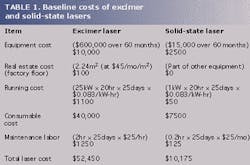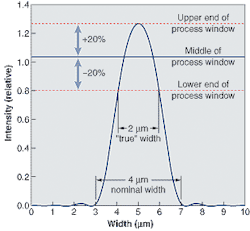Solid-state lasers challenge excimers in IC processing
James Flores, Steve Droes, Pooran Joshi, Mark A. Crowder, and Tolis Voutsas
Laser processes are becoming popular in the production of integrated circuits (ICs) because they reduce thermal effects. One manifestation of this development is the rapid adoption of low-temperature polysilicon technology in the production of liquid-crystal displays and organic light-emitting diodes. The IC industry is considering laser processes for producing highly doped, ultrashallow junctions in metal-oxide semiconductor field-effect transistors.
Unfortunately, the expense of excimer-laser processing is a large burden for manufacturers of commodity devices. These costs are mostly associated with the massive size of excimer systems and their poor stability. Consequently, it is natural to consider whether diode-pumped solid-state (DPSS) lasers might cut costs substantially. Excimer and DPSS laser processing can be compared via examination of silicon film crystallization, a comparison that is suitable for other common IC processes such as dopant activation and film densification.
Comparing the basics
A distinctive characteristic of the excimer laser is its medium—a mixture of inert and halogen gases. A large volume of gas is required to generate adequate light flux; at the same time, a high voltage is needed for photon excitation. Being a disordered material, the gaseous gain medium contributes a partial incoherence to the laser beam. In contrast, the lasing medium of DPSS lasers is typically a polycrystalline ceramic. The dense and solid gain medium means smaller volumes and voltage thresholds, while its crystallinity improves coherence. For quasi-continuous-wave applications, high gain and fleeting excitation lifetimes produce repetition rates up to the order of 100 kHz. The best excimer laser operates at a relatively ponderous 0.3 kHz.
In an example comparison of these two types of lasers in use, thin-film transistors (TFTs) used in flat-panel displays are laser-crystallized. Results of TFTs whose channels were crystallized by either an excimer or DPSS laser indicate that DPSS lasers can produce TFTs that exceed target specifications for liquid-crystal-display backplanes.
Estimates of approximate baseline costs of DPSS and excimer laser systems can be made based on a 20-hour day and a 25-day month (see Table 1). Initial equipment investment is amortized over a 60-month operating period. An uptime efficiency of 90% is assumed. The listed labor cost for maintenance neglects an increase in operator training for excimer systems. Total laser cost for the DPSS laser is one-fifth that for the excimer laser.
The main concerns about DPSS lasers are a low power output—which implies slow throughput—and challenges in stretching and homogenizing the initial beam. Throughput costs can be estimated for a commercial laser system by accounting for the time needed to scan a substrate plus time for various motion adjustments. Using typical parametric values, the result indicates that a combination of two 30-W DPSS lasers could compete with a typical excimer system.
Another estimate of throughput was obtained from a Fujitsu report.1 The company's researchers used a 10-W DPSS laser to crystallize a silicon film across a 300 × 300-mm substrate. The beam was shaped into an ellipse about 20 μm wide and 0.4 mm long. It was learned that scan rates between 20 and 50 cm/s produced good TFTs. Assuming an overlap of 10% and a scan rate of 30 cm/s, a single substrate might be crystallized in about 14 min.
If the beams from two 30-W DPSS lasers were properly expanded, the cycle time would be little more than two minutes, which is tolerable for production. When throughput costs are added to the cost estimate, the overall cost of operation is clearly still smaller than a typical excimer system. Further reduction may be obtained from simplification of other system components, like substrate motion platform, optics, enclosures, and so on.
Beam shaping
A major challenge to crystallization by any laser is extending beam coverage uniformly across large areas. An excimer laser beam comprises many spatial modes, so it can only be focused to hundreds of microns. Excimer lasers are also spatially nonuniform. Although homogenization optics help, they introduce transmission losses and interference fringes from overlapping beams. Another limitation is that projection system optics can be made only so large and remain practical.
These problems pale compared to beam shaping of DPSS lasers. Although the high coherence of the laser enables focusing to a few microns (using diffractive optics), it impedes beam shaping. The initial output beam of a DPSS laser has a circular cross section and a Gaussian intensity distribution. Simply stretching the beam along one axis maintains the Gaussian profile all around, producing an oval-shaped spot (see Fig. 1). In this case, the scan overlap would be reduced to avoid generating bands of high- and poor-quality microstructure.Other factors
The difference between the largest and smallest energy densities for quality crystallization shrinks as the film thickness is made thinner. Diode-pumped solid-state lasers offer a smaller pulse-to-pulse variability than excimer lasers and therefore also a wider process window. The peak-to-peak variation for a typical DPSS laser is roughly 1% to 2%, whereas for excimer lasers the variation is approximately 3% to 4%.
Most excimer lasers emit in the ultraviolet (UV) spectrum where silicon absorption is nearly independent of wavelength, temperature, and state of matter (solid or liquid). The main disadvantage of excimer wavelengths is that glass optics cannot transmit UV light well, so expensive optical elements must be used.
Because a diode-pumped solid-state laser typically emits near 1.06 μm, its frequency must be doubled (532-nm green light) or tripled (355-nm near-UV light) for the laser to affect silicon significantly. Unfortunately, each multiple increment in frequency approximately halves power efficiency. Absorption at visible wavelengths is strongly temperature dependent and changes substantially during melting. Therefore, process variation may be larger for green beams. On the other hand, researchers at the University at Stuttgart found that the standard deviation of electron mobility across a 5 × 5-cm2 glass sample was 5%.2 The green beam is also safer to use, and its output power would be easier to increase.
More power coming
Substantial improvements to both DPSS and excimer lasers are expected—for example, in the availability of more-powerful lasers. Excimer-laser manufacturers now sell lasers that emit 1-J pulses and claim that a 2-J laser will be available in 2002.3 A 5-J laser reportedly will follow; its size will not be much larger than that of a 1-J laser.In technology trends for 532- and 355-nm-emitting DPSS lasers, average power output is expected to rise (see Table 2). Q-switching is expected to increase the peak pulse power to the order of megawatts and will offset a major disadvantage of DPSS lasers, albeit at the cost of energy efficiency and repetition rate. Overall, the prospects for DPSS laser systems in IC materials-processing applications are more favorable than those for excimer laser systems. Besides being much more compact, DPSS lasers are also less expensive to buy, operate, and maintain. Depending upon what materials-processing result is desired, DPSS lasers could provide a cheaper alternative to excimer lasers.
REFERENCES
1. A. Hara et al., IEDM Tech. Digest, 34.2.1 (2001).
2. R. Dassow et al., MRS Symp. Proc. 621, Q9.3.1 (2000).
3. A. Demin et al., MRS Symp. Proc. 695E, D7.2 (2001).
4. Private communication
JAMES FLORES, POORAN JOSHI, MARK CROWDER, and STEVE DROES are members of the technical staff and TOLIS VOUTSAS is a manager in the LCD Process Technology Group at Sharp Laboratories of America, 5700 Pacific Rim Blvd., Camas, WA 98607; e-mail: [email protected].



